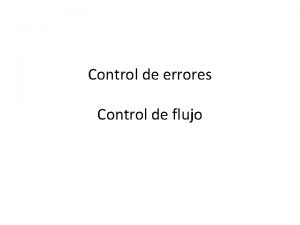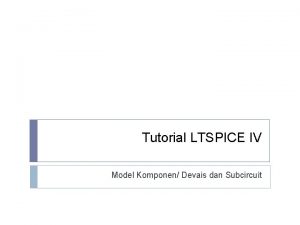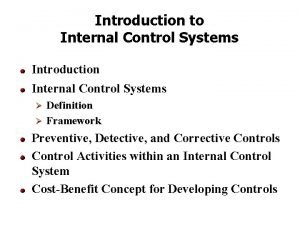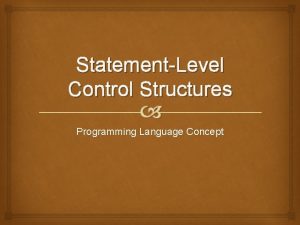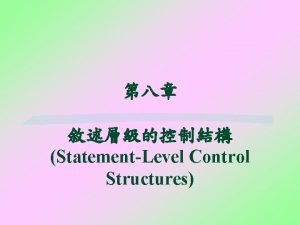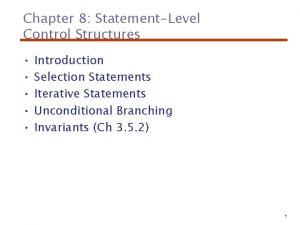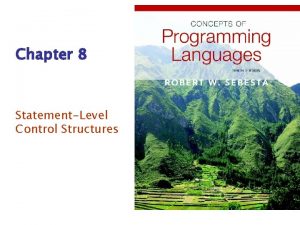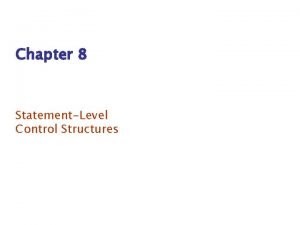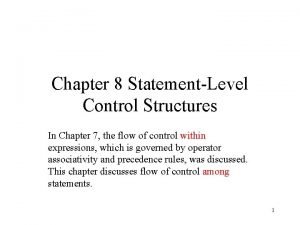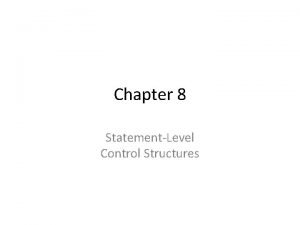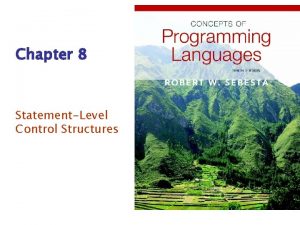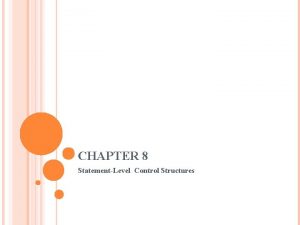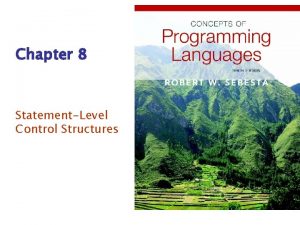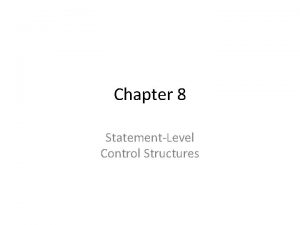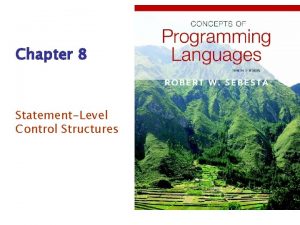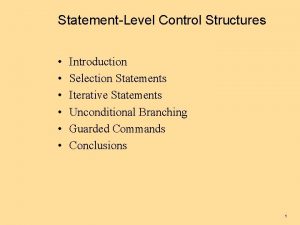Chapter 8 StatementLevel Control Structure Introduction Levels of
















- Slides: 16

Chapter 8 Statement-Level Control Structure

Introduction • Levels of Control Flow: 1. Within expressions 2. Among program units 3. Among program statements. A control structure is a control statement and the collection of statements whose execution it controls.

Selection Statements A selection statement provides the means of choosing between two or more execution paths in a program. Design Issues: 1. What is the form and type of the control expression? 2. What is the selectable segment form (single statement, statement sequence, compound statement)? 3. How should the meaning of nested selectors be specified?

Single-Way Examples FORTRAN IF: IF (boolean_expr) statement Problem: can select only a single statement; to select more, a goto must be used, as in the following example

Two-Way Selection Statements Although the two-way selection statements of contemporary imperative languages are quite similar, there are some variations in their designs. The general form of a two-way selector is as follows: if control_expression then clause else clause

Design Issues: The design issues for two-way selectors can be summarized as follows: • What is the form and type of the expression that controls the selection? • How are then and else clauses specified? • How should the meaning of nested selectors be specified?

Two-way Selector Examples ALGOL 60 if: if (boolean_expr) then statement (the then clause) else statement (the else clause) - The statements could be single or compound

Nesting Selectors e. g. (Pascal) if. . . then. . . else. . . Which then gets the else? Pascal's rule: else goes with the nearest then.

Selector Expressions In the functional languages ML, F#, and LISP, the selector is not a statement; it is an expression that results in a value. Therefore, it can appear anywhere any other expression can appear. Consider the following example selector written in F#: Let y = if x > 0 then x else 2 * x; ; This creates the name y and sets it to either xor 2 * x, depending on whether x is greater than zero.

Multiple-Selection Statements The multiple-selectionstatement allows the selection of one of any number of statements or statement groups. It is, therefore, a generalization of a selector. In fact, two-way selectors can be built with a multiple selector. Design Issues: 1. What is the form and type of the control expression? 2. What segments are selectable (single, compound, sequential)?

Design Issues 3. Is the entire construct encapsulated? 4. Is execution flow through the structure restricted to include just a single selectable segment? 5. What is done about unrepresented expression values?

Consider the following example: Switch (index) { case 1: case 3: odd += 1; sumodd += index; case 2: case 4: even += 1; sumeven += index; default : printf("Error in switch, index = %dn", index); } This code prints the error message on every execution.

Iterative Statements An iterative statement is one that causes a statement or collection of statements to be executed zero, one, or more times. An iterative statement is often called a loop. General design Issues for iteration control statements: 1. How is iteration controlled? 2. Where is the control mechanism in the loop?

Counter-Controlled Loops A counting iterative control statement has a variable, called the loop variable, in which the count value is maintained. It also includes some means of specifying the initial and terminal values of the loop variable, and the difference between sequential loop variable values, often called the step size. The initial, terminal, and step size specifications of a loop are called the loop parameters.

Design Issues: 1. What is the type and scope of the loop var? 2. What is the value of the loop var at loop termination? 3. Should it be legal for the loop var or loop parameters to be changed in the loop body, and if so, does the change affect loop control? 4. Should the loop parameters be evaluated only once, or once for every iteration? The general form of C’s for statement is for (expression_1; expression_2; expression_3) loop body The loop body can be a single statement, a compound statement, or a null statement.

Unconditional Branching An unconditional branch statement transfers execution control to a specified location in the program. Problem: readability. - Some languages do not have them: e. g. , Modula-2 and Java e. g. goto statement.
 Who made costa's level of thinking?
Who made costa's level of thinking? Body paragraph structure
Body paragraph structure Translational research institute on pain in later life
Translational research institute on pain in later life Distinguish between process control and product control
Distinguish between process control and product control Reynolds transport theorem
Reynolds transport theorem Stock control e flow control
Stock control e flow control Control volume vs control surface
Control volume vs control surface Lac operon positive or negative control
Lac operon positive or negative control Positive and negative controls
Positive and negative controls Data link control
Data link control Control de errores
Control de errores Negative control vs positive control examples
Negative control vs positive control examples Flow and error control
Flow and error control Scalar control vs vector control
Scalar control vs vector control Komponen pada ltspice
Komponen pada ltspice Internal control introduction
Internal control introduction Social control in sociology
Social control in sociology










